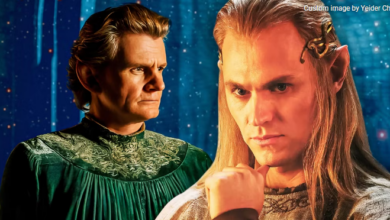The Rings Of Power’s Sauron Reveal Fixed A Major Lord Of The Rings Movie Problem
Sauron wasn’t as effective a villain as he could have been in the Lord of the Rings movies, but The Rings of Power’s Halbrand fixes this problem.
The Lord of the Rings: The Rings of Power revealed that one of its central characters was actually the Dark Lord Sauron, and this solved an old Lord of the Rings problem. The Prime Video series took some liberties with Tolkien canon, giving Sauron a form called Halbrand that had never been described in the source material. Of course, The Silmarillion did explain that, before The Lord of the Rings, the Middle-earth villain had the ability to take different forms and that he used this to his advantage to seduce and influence various people. Still, the central Lord of the Rings books and movies lacked this information, and Sauron’s character suffered as a result.
In the finale of The Rings of Power season 1, Galadriel put the pieces of Halbrand’s true identity together, and it was a twist that took even Tolkien experts by surprise. Though the Lord of the Rings books and movies never gave much depth to Sauron’s character, the posthumously published Silmarillion described how the Dark Lord used to use the beautiful form of Annatar to trick the Elves and Men of the Tolkien universe into doing what he wanted. Halbrand seems to be The Rings of Power’s version of this character, and, though different, this serves the same purpose of making the Lord of the Rings villain far more interesting.
The Lord Of The Rings’ Depiction Of Sauron Is Lacking

For many who have never read The Silmarillion, The Rings of Power’s Halbrand is their first up-close look at Sauron. Both the Lord of the Rings books and movies took the perspective of the heroes, and the Middle-earth villain felt more like an invisible force than a physical threat. In Peter Jackson’s trilogy, Sauron was depicted as a sort of armored monster before he lost his One Ring, and by the start of Frodo’s journey, he was just a flaming eye atop his tower in Mordor. This made this Dark Lord of Middle-earth seem somewhat lacking in the way of villains. Aside from just being evil, there was very little to know about his character—if Sauron could even be called that.
In the Lord of the Rings books, Sauron was discussed a little more and was considered an actual person with plans and goals, as well as a physical form. Still, since Frodo and co. never actually met the villain face-to-face, Sauron was more of an idea than a corporeal threat. This changed with the release of The Silmarillion after Tolkien’s death. Readers could learn more about Sauron’s history and see him more as an actual Lord of the Rings character. Even then, The Silmarillion read more like a history book than a novel, so Tolkien fans have never had the chance to get to know the characters introduced there.
The Rings Of Power’s Sauron Reveal Gives The Villain More Depth

The benefit of bringing Middle-earth’s Second Age to the screen is the opportunity to see these characters in a “storytelling” format. So, even though Halbrand wasn’t precisely what Tolkien fans had been expecting, he is still the first up-close-and-personal look at Sauron on screen. Through Halbrand, we can get to know the villain’s personality in a whole new way. His strengths, weaknesses, temptations, motivations—even a sense of humor—it’s all being laid out for audiences to see. This is especially enhanced by the fact that Halbrand’s true identity was kept a secret for the majority of The Rings of Power season 1. Like Galadriel, viewers had begun to like him before learning the truth.
Just as The Silmarillion retroactively shifted the way Sauron’s actions are perceived in The Lord of the Rings, the Halbrand reveal in The Rings of Power allows audiences to see Peter Jackson’s films in a whole new light. Now, rather than a faceless, seemingly imaginary threat in Middle-earth, there is now a concrete identity to connect to the name of Sauron. Of course, The Rings of Power’s version of the character can’t strictly be considered canon. However, this isn’t to say that Halbrand doesn’t fit along with Tolkien’s version of the Middle-earth villain.
The Rings Of Power’s Sauron Is True To J.R.R. Tolkien’s Vision

Tolkien canon describes how Sauron, like Gandalf, Saruman, and Radagast, was a Maia, an angel-like being tasked with assisting in the creation and maintenance of the world. These beings are shapeshifters, able to take any form that fits their fancy. When Sauron switched to the side of evil, he used his abilities to his advantage and took on beautiful forms that the Elves and Men of Middle-earth were most likely to trust. The most discussed version of Sauron, Annatar, was the one who tricked the Elves of Eregion into making the Rings of Power. Though Halbrand differs from this form, his behavior and plan in The Rings of Power align with Annatar’s canon story.
Based on canon, Halbrand wasn’t lying in The Rings of Power season 1 finale when he told Galadriel that he wanted to fix the damage done by Morgoth. According to Tolkien’s notes, Sauron had turned away from Morgoth’s mission before the Dark Lord was defeated and planned to reunite the beings of Middle-earth and rule over a beautiful and healed new world. Of course, just as was seen in the conflict between Galadriel and Halbrand in The Rings of Power, dominion is a slippery slope to domination, especially when the One Ring is involved. Understanding this entirely shifts the perception of Sauron’s Lord of the Rings character—and that’s the entire point.



